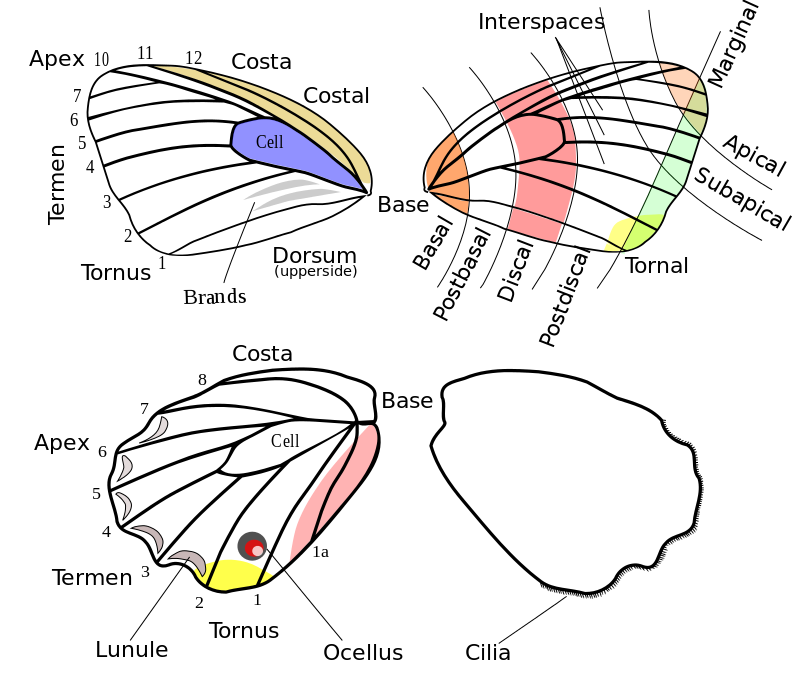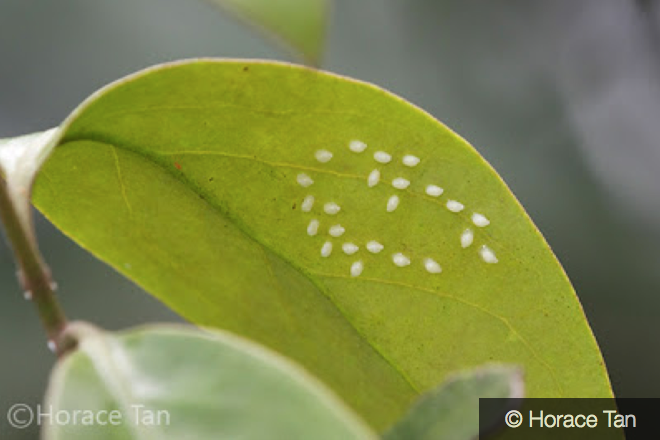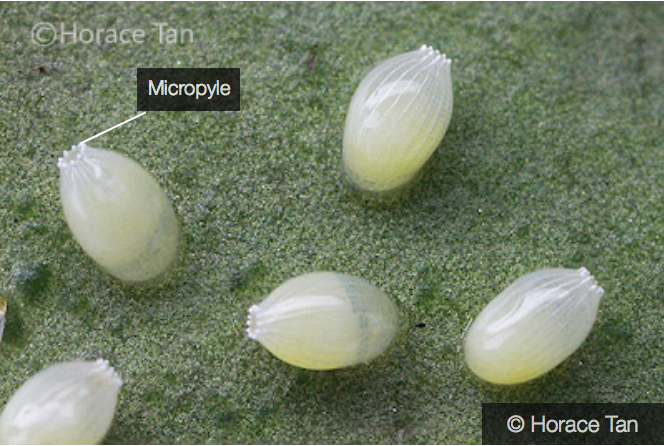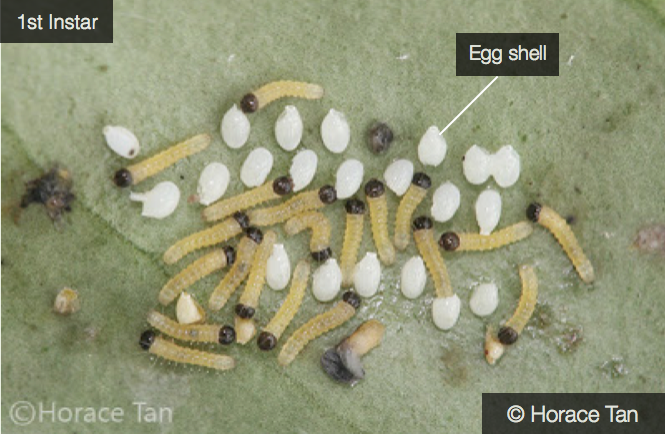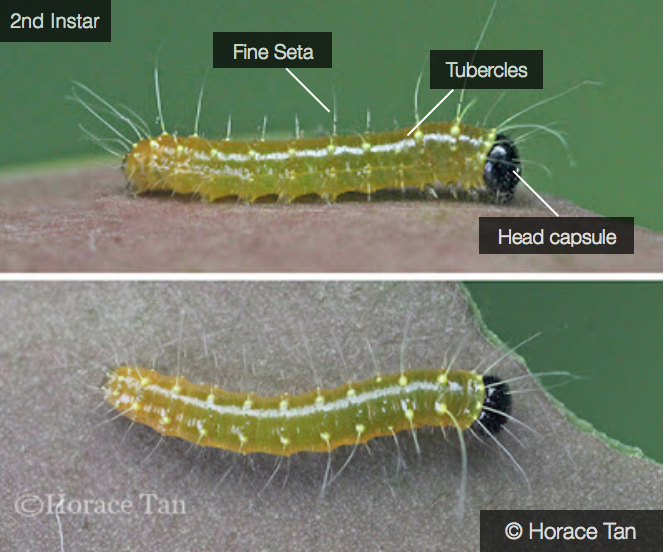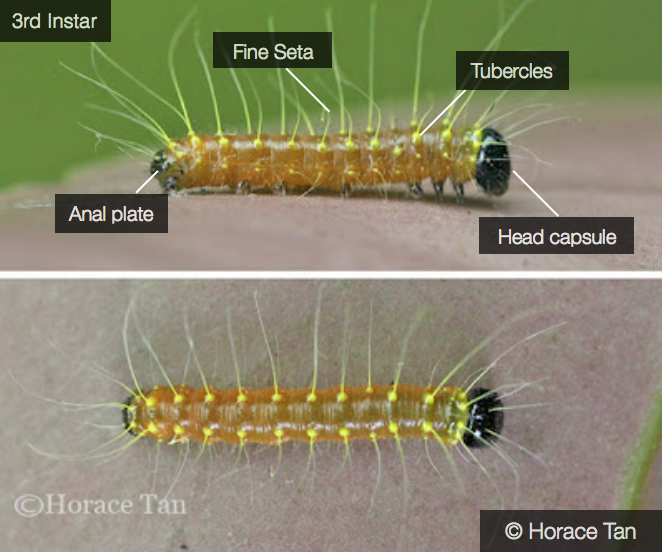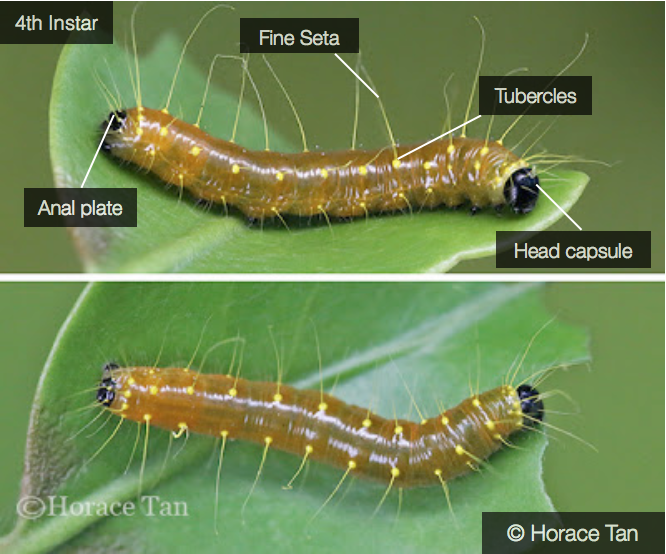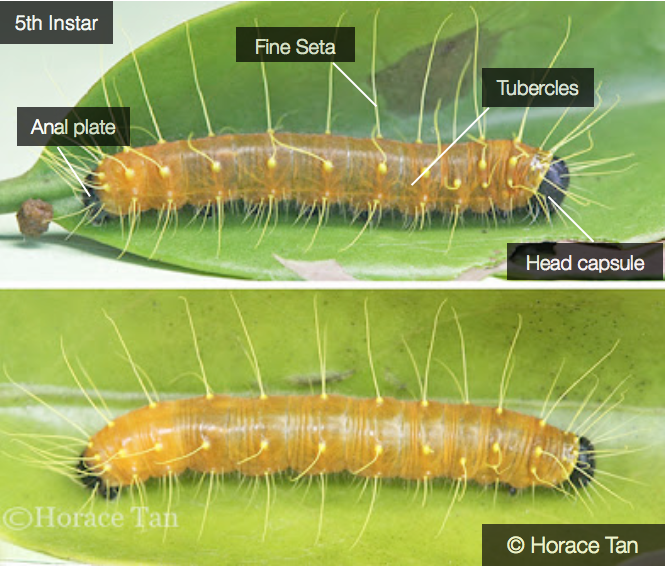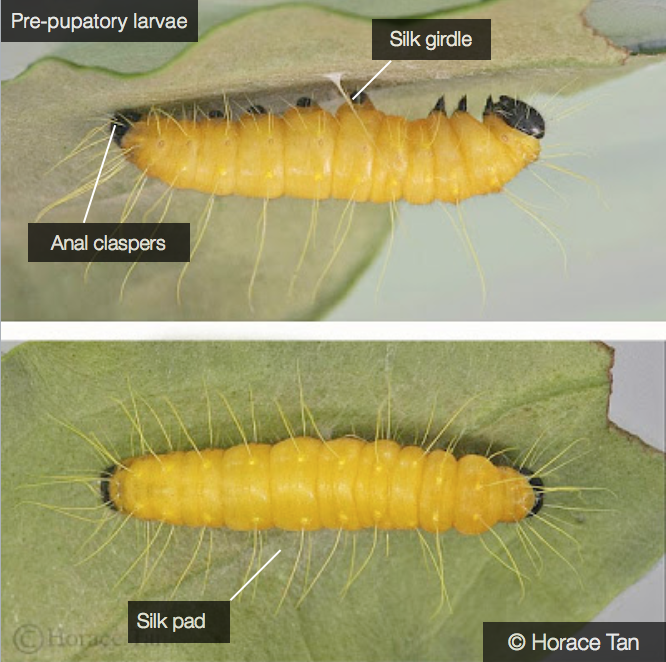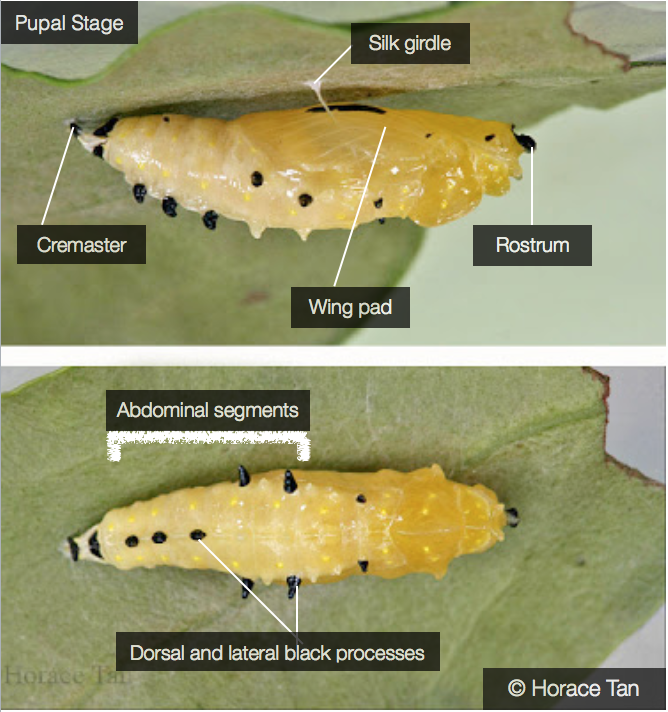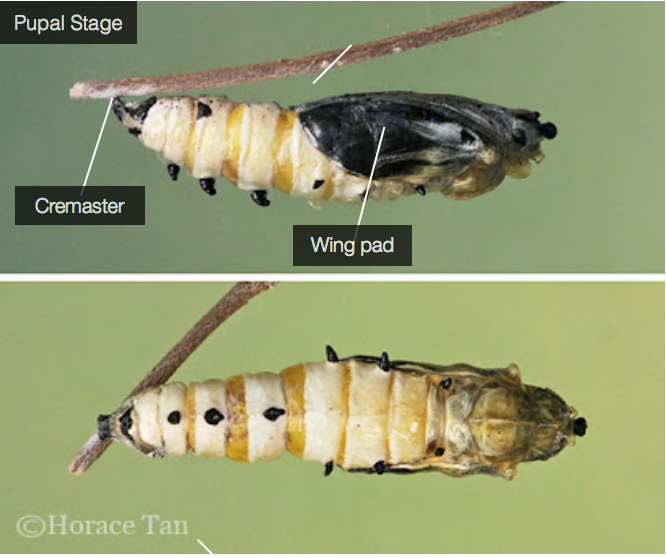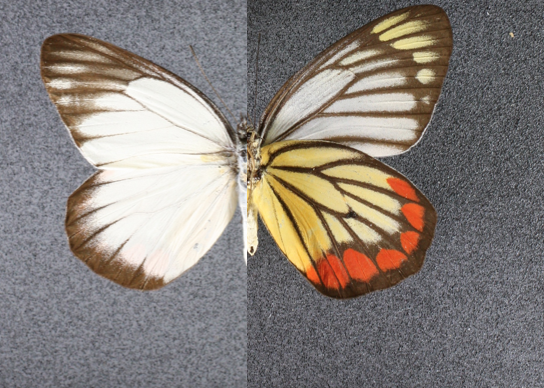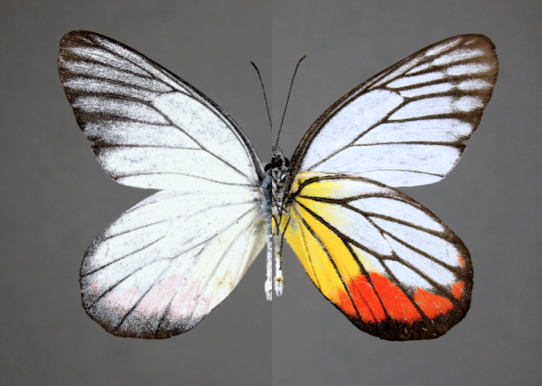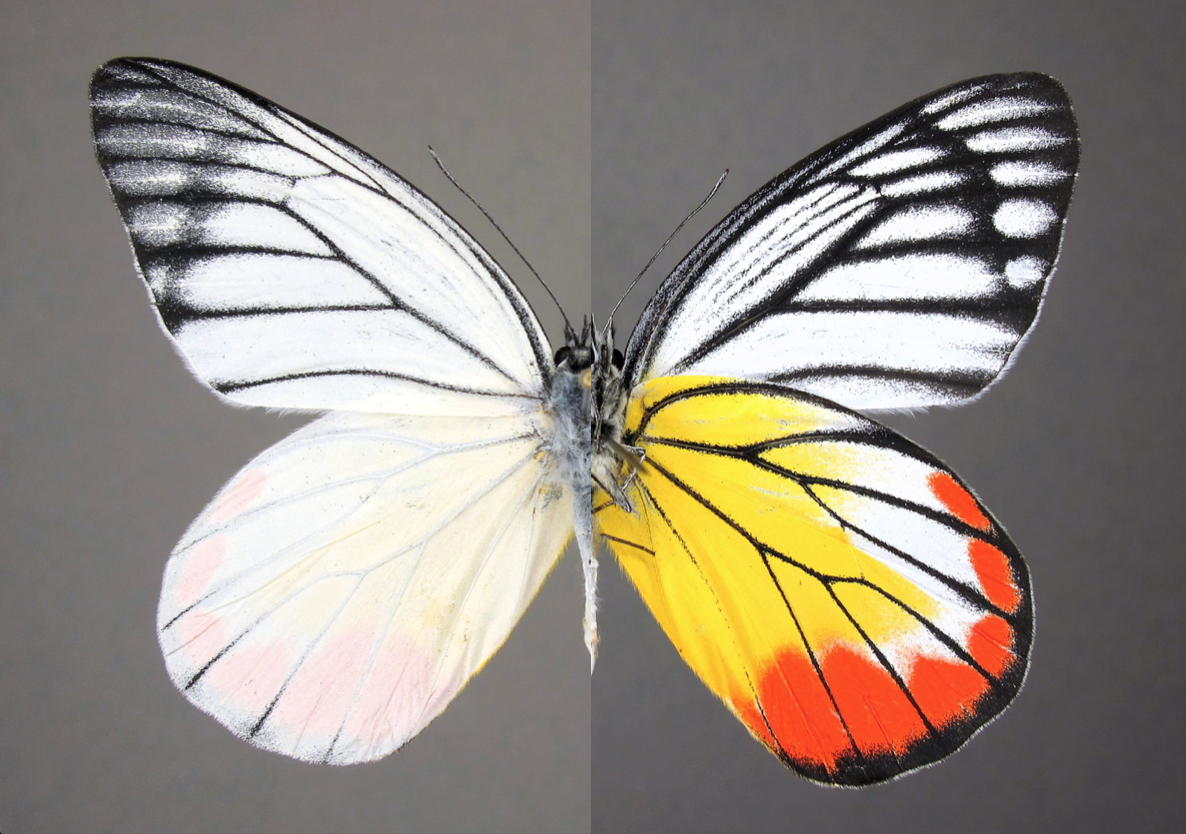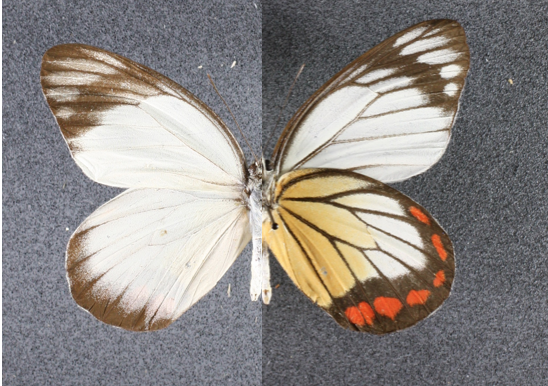Painted JezebelDelias hyparete (Linnaeus, 1758)
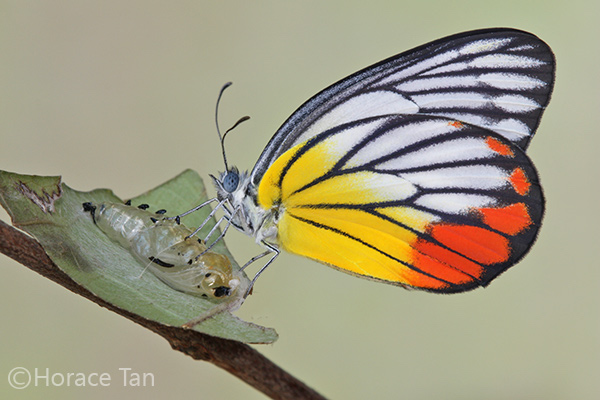 |
| A newly eclosed Delias hyparete metarete. Credit: Horace Tan (Permission obtained) |
Table of Contents
Originally described as Papilio (Danaus) hyparete (Linnaeus,1758)
Common Name: Painted Jezebel
[1] Introduction
The Painted Jezebel, Delias hyparete, is a common pierid butterfly widely distributed throughout most parts of Asia spanning across areas such as East India, South China, the Malay Peninsula, Java, Indonesia, Vietnam, Brunei and the Phillippines. It belongs to the genus Delias, which is the largest of the family Pieridae. Compared to other pierids, Delias adults are easily recognized by their striking patterns and vibrant coloration on their ventral side, especially of the ventral hind wings [1]. Popularly known as the Jezebels, these butterflies usually possess contrasting colors of black, white, yellow and red.
In Singapore, it is the subspecies Delias hyparete metarete, found mainly in the Southeast Asian region, that is commonly sighted in both urban and forested habitats here[9]. It is likely to be the only representative of the genus Delias left in Singapore; the other species, Delias pasithoe parthenope, the Redbase Jezebel is thought to be locally extinct. Therefore, this page will focus mainly on the subspecies found in Singapore, Delias hyparete metarete.
[1.1] Etymology
The word 'Jezebel' used in their common name stems back from biblical times, where it was written in the Book of Kings that Jezebel was a 9th century Phoenician princess who was married to King Ahab of Israel. She was depicted in the Bible as an immoral and vain queen whom encouraged idolatry and was eventually killed by Jehu. It was written that Jezebel insisted on dressing in all her finery and painted black kohl around her eyes to look her queenly best in her last moments before death. As time went by, the word 'Jezebel' has come to gain negative connotations and is commonly associated with promiscuity and immorality.
There is a lack of documented information with regards to the etymological origins of the binomial name Delias hyparete. In fact, the species hyparete was originally described by Linnaeus in 1758 as Papilio (Danaus) hyparete where the word 'papilio' is latin for butterfly. However, the subspecies Delias hyparete metarete was most likely named by Arthur Gardiner Butler in 1879 for the butterfly’s extreme similarity to the previously described Delias hyparete and also for its later discovery as the word ‘meta-‘ in ‘metarete’ originates from the Greek preposition and prefix (μετά-) meaning “after, behind”.
[2] Morphology
Butterflies are usually described or identified by their wing structure, colour and pattern although it must be noted that colour and pattern can also vary within a species. The illustration below shows the different regions of the wings as referred to by the different terms for a better understanding of the terms that will be used to diagnose and describe the Painted Jezebel, Delias hyparete metarete in this species page.
The Painted Jezebel is a medium-sized butterfly with a wingspan of 70-80mm that is easily identified by the intense colouration of red, yellow, and white on the undersides of its hindwings which have a yellow basal area with a bright red marginal border along the termen. The wings are white on the upperside with veins also dusted black[5].
[2.1] Sexual Dimorphism
Like most butterflies, there are distinct morphological differences between the males and females of the same species. This phenomenon is known as sexual dimorphism. In this case, it is easy to distinguish the the females of Delias hyparete metarete from the males as the females tend to have the dorsal surface of their wings more heavily dusted with black scales[5].
|
|
[3] Life History
[3.1] Host Plant
Like all other lepidopterans, the Painted Jezebel is holometabolous, meaning that they go through a complete metamorphosis through four stages in their life cycle: egg, larva, pupa and the adult. Throughout their lives, most butterflies form a close association with the plant community. For these butterflies, life begins as an egg laid on what is known as a larval host plant. Larval host plants are food plants for the caterpillar (larva) of the butterfly. Some species only recognise and use a single larval host, while other species may have several host plants. These host plants will provide shelter, nutrition and even certain chemicals needed for the larvae to complete their growth and development [16].
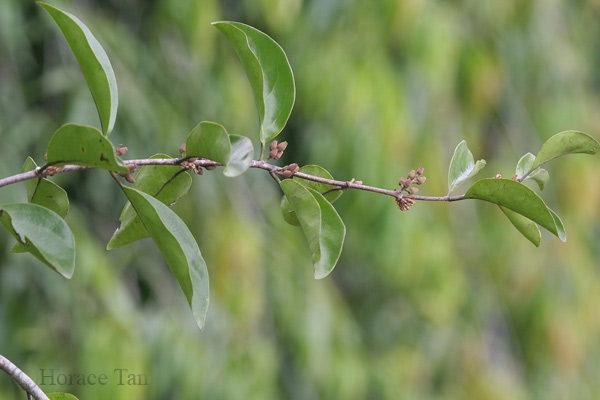 |
| Malayan Mistletoe - Host plant of the Painted Jezebel. Credit: Horace Tan (Permission obtained) |
In this case, the host plant for the Delias hyparete metarete is the Malayan Mistletoe, Dendrophthoe pentandra. One of the most common mistletoes found in Singapore, these plants can be frequently found on both roadsides, park and garden trees. The Dendrophthoe pentandra are classified under the family of Loranthaceae which falls in the order Santalales. As a general rule, the larvae of the butterflies belonging to the genus Delias are observed to feed mainly on parasitic "mistletoes" of the order Santalales[1].
[3.2] Developmental Stages
In this section, the life cycle of Delias hyparete metarete will be outlined using information mainly adapted from the informative website ButterflyCircle and the guidebook Caterpillars of Singapore's Butterflies[13,20].
| Ovum Stage Duration: 5 days The eggs of the Painted Jezebel are pale-yellow in colour and shaped like a spindle. They are normally laid in a loose cluster on the undersides of the Malayan Mistletoe leaves with one end attached to the leaf and its crown pointing outwards. They have a thin shell with raised reticulations with the micropyle located at the top of each egg. |
|
||||
| Larvae Stage The Painted Jezebel’s caterpillar goes through five developmental stages, also known as instars.The caterpillar is orange-brown in colour and has rows of long and soft yellowish bristle on the dorsal and dorso-lateral axes of its cynlindrical body along with a black head capsule. 1st Instar Length of caterpillar: 2.2-4.0mm Duration of Instar Stage: 3-3.5 days The first instar caterpillar is pale-yellow in colour and fine setae can be observed on the dorsal and lateral axes of its body. The caterpillars may consume some of its egg shell but mostly feed on the tissues of the leaf until only the upper epidermis remained. As growth progresses, there will be a few holes present in the leaf, near the site of oviposition. |
|
||||
| 2nd Instar Length of caterpillar: 4-7mm Duration of Instar Stage: 3.5-4 days The 2nd instar caterpillar has adopted a more yellowish-brown colouration with dorso-lateral and lateral rows of bright yellow tubercles. At this stage, a small and indistinct black anal plate can be observed at the posterior end of the caterpillar. |
|
||||
| 3rd Instar Length of caterpillar: 7-14mm Duration of Instar Stage: 3-4 days At the 3rd instar stage, the tubercles becomes even more intense in colouration with the soft setae being of a similar colour. The anal plate also becomes larger. |
|
||||
| 4th Instar Length of caterpillar: 14-22mm Duration of Instar Stage: 3.5-4 days There are no distinct differences between the morphologies of the 3rd and 4th instar caterpillar. At this stage, there is only a noticeable difference in the length of the caterpillar. |
|
||||
| 5th Instar Length of caterpillar: 22-36mm Duration of Instar Stage: 5-6 days At this stage, the black anal plate is observed to be even larger in size in comparison to the earlier instars. The caterpillars can be seen to behave ‘sluggishly’ and goes into a “wandering” stage to search for a site to pupate. The body of the caterpillar shortens and the body gradually changes its colours to become golden yellow. Before pupation happens, the caterpillar will secure its body to the site of pupation by spinning a silk pad and two silk girdles. The posterior end of the caterpillar will be attached to the silk pad through the use of anal claspers, and silk girdle suspends the body at the mid-section. Video credit: Dr. Wee Yeow Chin of BESG (Permission obtained) |
|
||||
| Pupal Stage Length of pupa: 24-25mm Duration of Pupation: 7-8 days Pupation will take place within 0.5-1 days from the last day of the 5th instar caterpillar. The pupa will still be suspended through the same silk girdle but instead of anal claspers, the pupa now attaches it posterior end to the silk pad through the cremaster, a hook-shaped projection at the end of the chrysalis casing. The golden yellow pupa has a black rostrum at its anterior end; with dorsal spinous processes found across most body segments. Spiky black lateral processes can also be observed in the early abdominal segments with a variable number of black markings on the wing pad. When disturbed, the abdominal segments of the pupa will flinch from left to right. A day before the adult butterfly emerges, the mature pupa becomes translucent and the pupal stage will come to an end. |
|
Eclosion is the emergence of an adult insect from its pupal case. During this process, the butterfly will emerge from the chrysalis through the anterior portion. Once out of the chrysalis, the butterfly will usually hang on to the empty casing to pump blood into the veins of its unexpanded wings before flying off. Meconium, the reddish excretory fluid left over from metamorphosis will also be secreted by the newly emerged butterfly.
| Video credit: Horace Tan of ButterflyCircle (Permission obtained) |
Video credit: Dr. Wee Yeow Chin of BESG (Permission obtained) |
[4] Behaviour and Ecology
[4.1] Feeding Behaviour
Video credit: Dr. Wee Yeow Chin of BESG (Permission obtained)
The larvae of Delias hyparete metarete are gregarious feeders, that is they tend to feed in groups[1]. The caterpillars are observed to line themselves along the feeding margin of the host plant leaf. When viewed from above, only the black heads of the caterpillars are visible. If there is any disturbance, they will stop feeding and retract from the edge to rest before embarking on another frantic bout of eating.
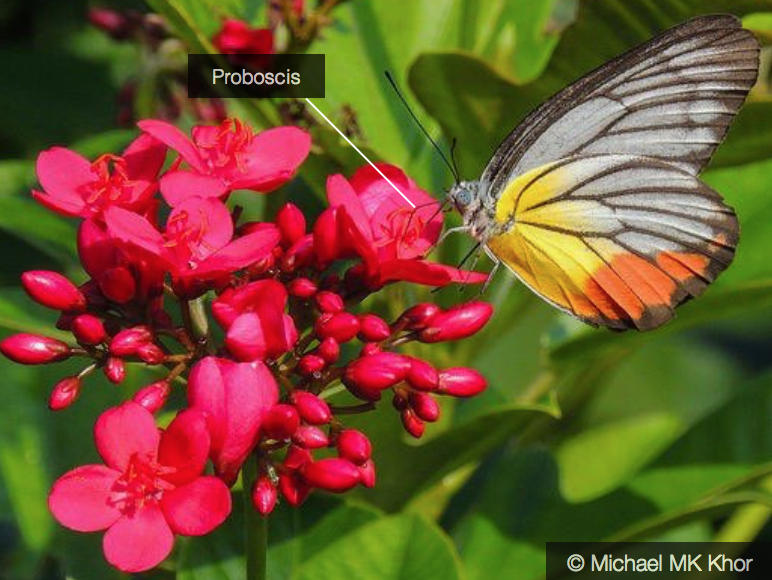 |
| Adapted photograph of a Delias hyparete metarete extending its proboscis to feed on a flower. Credit: Michael MK Khor. Creative Commons 2.0 |
Most adult butterflies feed on nectar which can be obtained from flowers. The adult Delias hyparete metarete butterfly do not have chewing mouth-parts unlike their larvae form. Instead, adult butterflies possess an extendable proboscis which can be uncoiled to probe a flower's corolla tube to take up liquid food (nectar). By contracting the proboscis's muscles, the butterfly is able to create a difference in air pressure within the hollow cavity as compared to the air pressure of the surroundings. This results in the nectar moving up the proboscis, allowing the butterfly to feed. When resting or in flight, the proboscis will be held up in a coil under the head[17].
[4.2] Basking
Butterflies require elevated body temperatures of between 30–40°C above ambient temperatures to meet the thermal requirements for flight[22]. As such, most butterflies are active during daylight in good weather, one can observe a peak in butterflies' activity from around 9am in the morning before it starts to taper off in the late afternoon at around 4pm [6]. To achieve such temperatures, butterflies rely on basking and behavioural thermoregulation by posturing their wings relative to the sun. There are several documented basking strategies but pierids such as the Painted Jezebel are commonly observed basking in a lateral fashion whereby the wings are folded tightly over the butterfly's body with the ventral wing surfaces positioned in a perpendicular manner to the sun[21]. During lateral basking, radiation is absorbed by the basal region of the hindwings and veins present within the wings will conduct the heat to the thorax. The amount of radiation that the butterfly's wings are capable of absorbing is dependent on the proportion of black, melanin scales present on the wings. It is common to see the Delias hyparete metarete basking on leaves with their wings closed.
[4.3] Flight pattern
The Painted Jezebel are lofty fliers that have a flight pattern that is described as nonchalant with a slow wing beat [9]. They normally fly at near the canopy level but occasionally do frequent nectaring flowers that are close to the ground.
Video credit: sunch28 (Creative Commons License)
[4.4] Biological control of parasitic plant
The Painted Jezebel may also act as a natural control of its host plant, the semi-parasitic Malayan Mistletoe according to researchers who had noticed that the plant tends to be fully defoliated by the larvae and had withered off on several occasions. Thus, the Painted Jezebel can prevent excessive infestation of the Malayan Mistetoe which is perceived as a pest to fruit trees as they might be damaged by injurious parasitic plants like the mistletoe that tap into the host tree's tissues to obtain water and nutrients[15]
[5] Distribution
[5.1] Habitat
The Painted Jezebel is commonly found in the lowlands but can also occur at moderate elevations up to 4,000ft[5]. In Singapore, this butterfly frequents both inland and coastal forests, including those of secondary growth. The casual nature observer is also likely to come across this beautiful pierid in parks, gardens and villages where the host plant Dendrophthoe pentandra is also frequently found[9].
[5.2] Global Distribution
| Google map of Delias hyparete and its various subspecies. Created by Jocelyn Wee. To view what subspecies belong to which locality, click on the marker in the Google map. |
Being one of the most diverse species of Delias, Delias hyparete and its subspecies have the largest distribution area that ranges from South China to the Malay Archipelago. Each marker on the map is labelled with the region and the particular subspecies of that locality. For a summarised version, the list of the various described subspecies of Delias hyparete and their respective locality is stated below.
| Range: |
hyparete |
- Java, Madura Island, Kangean Island, Bawean Island, Bali, Lombok |
| hierta |
- S. China, Hong Kong |
|
| luzonensis |
- Luzon, Taiwan, Mindoro, Marindugue, Sibuyan, Polilio, Negros, Cebu, Bohol, |
|
| Panay, Samar, Leyte, Panaon Island |
||
| mindanaensis |
- Mindanao |
|
| haemorrhea |
- Bangka Island |
|
| indica |
- Nepal, Myanmar, Thailand, Laos, Vietnam, Hainan, Yunnan |
|
| metarete |
- Malay Peninsular, Andaman Island, S. Thailand |
|
| niasana |
- Nias Island, Banyak Island |
|
| ethire |
- S. India |
|
| lucina |
- Jolo Island, Sulu Island |
|
| palawanica |
- Palawan, Calamian Island |
|
| aurago |
- Belitung Island |
|
| hypopelia |
- Sipora Island |
|
| diva |
- Borneo, Laut Island, Karimata Island |
|
| jakata |
- Batu Island |
|
| despoliata |
- Sumatera |
|
| domorana |
- Domoran Island |
|
| isawae |
- Anambas Island, Singkep Island, Lingga Island |
|
| itohi |
- Simeulue Island |
|
| melville |
- Balabac Island |
[5.3] Native Distribution (Painted Jezebel Watch)
| Map of local distribution of Delias hyparete metarete. Created by Jocelyn Wee |
Delias hyparete metarete can be found throughout Singapore in parks, gardens, forests and even amongst urban dwellings. If you see this butterfly around, please feel free to report your sightings by adding in a marker on the Google Map with a brief description of the (i) time of sighting, (ii) number of Painted Jezebels sighted, and (iii) behaviour of the Painted Jezebel. Together, we can monitor the population and distribution of this beautiful pierid throughout Singapore!
[6] Conservation Status

The Painted Jezebel has not yet been assessed for the IUCN Red List but it is likely that it is not under immediate threat in Singapore as it is listed as common under the Singapore National Parks Board.
[7] Diagnosis
[7.1] What is a subspecies?
The subspecies concept was first used in the late 19th century as a formal mean to document distinct geographical variation within a species based on morphological differences[18].
In general, a subspecies can be defined as an aggregation of phenotypically similar populations of a species inhabiting a geographical subdivision within the overall range and bearing distinct morphological differences from other such designated subdivisions[19].
According to the rules of the International Code of Zoological Nomenclature (ICZN), subspecies are recognised as a taxonomic rank beneath that of a species and are assigned a formal trinomial name, which is the combination of three names (e.g. Delias hyparete metarete). However, a subspecies cannot be recognised as an independent entity; a species will either be acknowledged as having no subspecies at all or having at least two[25].
[7.2] How did the various subspecies of Delias hyparete came into existence?
 |
| Map of Sundaland. Credit: Maximilian Dörrbecker. Creative Commons 3.0 |
It is well established that the Malay Peninsula, along with the large islands of Borneo, Java, and Sumatra and the satellite islands of Philippines, were all part of a large continent known as Sundaland. During the last ice age which happened in the last stages of the Pleistocene Age, about 126,000 to 11,000 years ago, the entire landmass was exposed due to the fall in sea-level, resulting in the formation of uninterrupted land passages between the neighbouring islands and present-day Malay Peninsula. However, the Earth's climate is never constant. Subsequent interglacial (warm) periods due to the variation of the Earth's climate would cause the melting of glaciers in colder regions, resulting in rising sea levels which would flood the low-lying regions of Sundaland, causing the continent to disintegrate into islands again[23]. This continual alternation of warm and cold periods would led to the repeated formation of islands. As reproductive/geographical isolation is a potent force in driving the process of speciation, when insular representatives or populations of a widely distributed species, like the Delias hyparete, gets isolated on various islands during the interglacial periods, favourable conditions on the islands can result in the development of distinct geographical races (subspecies) due to the minimal gene flow between the various geographic races over a long period of time[5]. This is evident from the described subspecies of Delias hyparete whereby most of them are of an insular (island) origin.
Delias hyparete has approximately 20 described subspecies. These subspecies vary from each other in terms of morphological characteristics such as wing patterns and colouration and thus, it is possible to diagnose the various subspecies of Delias hyparete through the observation and studying of the butterflies' pattern element which will be outlined in this section.
To look at pictures of all the various subspecies of Delias hyparete, head over to Delias of the World, an incredibly informative website on butterflies of the genus Delias.
Delias hyparete hierte Hübner, 1818
Delias hyparete luzonensis (C. & R. Felder, 1862)
Delias hyparete haemorrhoea (Vollenhoven, 1865)
Delias hyparete indica (Wallace, 1867)
Delias hyparete metarete Butler, 1879
Delias hyparete niasana Kheil, 1884
Delias hyparete amarilla Kheil, 1884
Delias hyparete ethire Doherty, 1886
Delias hyparete lucina Distant & Pryer, 1887
Delias hyparete palawanica Staudinger, 1889
Delias hyparete aurago Snellen, 1890
Delias hyparete hypopelia Hagen, 1898
Delias hyparete diva Fruhstorfer, 1899
Delias hyparete jataka Fruhstorfer, 1906
Delias hyparete ciris Fruhstorfer, 1910
Delias hyparete despoliata Fruhstorfer, 1910*
Delias hyparetedomarana Fruhstorfer, 1911
Delias hyparete panayensis Rothschild, 1925
[7.3] Diagnostic Key
This section aims to provide some helpful keys to distinguish between subspecies of Delias hyparete commonly found in the Oriental region whose ranges overlap.
| Delias hyparete hyparete Range: Java, Bali, Lombok, Bawean Island, Madura Island, Kangean Island Distinguishing features: Upperside: 1. Greyish apical area of primaries are less uniform2. Almost similar to Delias hyparete metarete but slightly shorter in the wings Underside: 1. Black margin near the red submarginal spots are bolder2. Compared to Delias hyparete metarete, the vermillion spots are of similar sizes and do not increase conspicuously in size for the posterior spots |
|
||
| Delias hyparete metarete Range: Southern Burma, Peninsular Malaya, Singapore, Thailand Malayan representative of Delias hyparete hierte, approaching closest to its northern form, Delias hyparete indica. Distinguishing features: Upperside: 1. More uniformly grey apical area on the upperside of the dorsal wings Underside: 1. More sharply defined limitation of the basal yellow area on the underside of its hindwings2. Chrome-yellow colour is confined to the base and posterior half of the wing; the apical half3. Development of black narrow margin of the anterior two or three vermillion-red spots4. Colours are purer and more rich in comparison to the race hierte |
|
||
| Delias hyparete indica Range: Nepal, India to Myanmar, Thailand, Laos, Cambodia, Vietnam, Hainan, S.China. Distinguishing features: Upperside: 1. Similar to Delias hyparete metarete but the colour is less dark and the veins are less defined Underside: 1. Larger expanse of yellow colouration as compared to Delias hyparete metarete |
|
||
| Delias hyparete hierte Range: Southern China, Hong Kong, Macau For a more detailed description, see here Distinguishing feature: Upperside: 1. Black margins to the veins are more diffuse Underside: 1. Black margin to the veins are much broader2. Larger expanse of chrome-yellow colouration and not separated from the vermillion-red submarginal spots by black borders3. Vermillion-red spots point inwards and increase in size posteriorly |
|
||
| Delias hyparete luzonensis This species is very variable in its form, depending on its locality. For more information, see here . Range: Phillipines (Luzon, Mindoro, Mindanao), Taiwan Malayan representative of Delias hyparete hierte, approaching closest to its northern form, Delias hyparete indica. Distinguishing feature: Upperside: 1. Darkened apical areas on the dorsal wings with less defined veins Underside: 1. Broader black border that surrounds the scarlet submarginal spots |
|
[8] Nomenclature
[8.1]Taxonavigation
- KINGDOM Animalia
- PHYLUM Arthropoda
- CLASS Insecta
- ORDER Lepidoptera
- SUPERFAMILY Papilionoidea Latreille, 1802
- FAMILY Pieridae Swainson, 1820
- GENUS Delias Hübner, 1819
- SPECIES EPITHET hyparete (Linnaeus, 1758)
Source: Global Biodiversity Information Facility (GBIF)
[8.2] Original Description
Delias hyparete was first described by Linneaus in the 10th edition of Systema Naturae (1758). He laid the foundation for scientific nomenclature and classification but in those times, Linneaus could only classify organisms together based on their structural similarities. For example, the class Insecta was divided into 7 orders, based chiefly on the form of the wings. Under this primitive form of classification, all specimens that had 2 similar pairs of wings covered with flat scales were placed within the order of Lepidoptera. Due to Linneaus's broad definition of shared characteristics, all butterflies were, as a result, placed under the genus Papilio. Therefore, the Painted Jezebel was initially described as Papilio hyparete before later work reassigned the species to the genus Delias.
 |
| Screenshot of the original description of Delias hyparete in Systema naturæ. Scanned document from the Internet Archive. |
The original description roughly translates to English as ‘spotless white, rounded wings; posterior veins of the lower spots red; Habitat in Java'.
 |
| Arthur Gardiner Butler, English entomologist. (Public Domain) |
It would be more than a century later before Butler would describe the subspecies of Delias hyparete, found in Singapore, Delias hyparete metarete in his paper, The Butterflies of Malacca, in 1879. In those days, the concept of subspecies was not yet conceived and thus Butler assigned this particular specimen to be of species status and was thus accordingly given a binomial name, Delias metarete. The Butterflies of Malacca was an influential and substantial paper in those days detailing a complete catalogue of 258 species of butterflies that inhabited the Malay Peninsula[5].
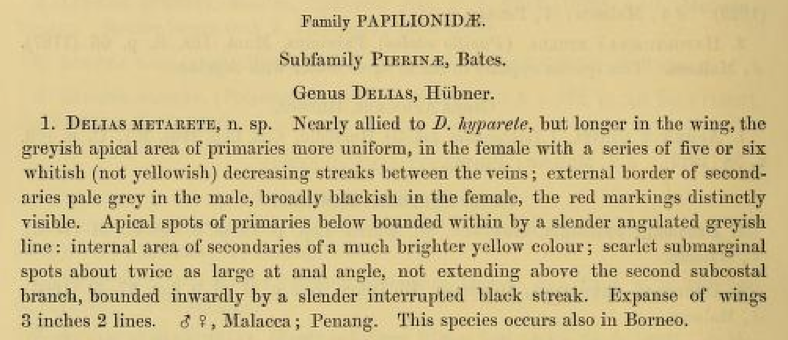 |
| Screenshot of the original description of Delias hyparete metarete by Butler. Scanned document from the Internet Archive. |
[8.3] Type Specimens
Whenever a new species or a subspecies is being formally described, the author will choose a particular specimen and designates it as the type of the species described.This is to help future researchers to resolve any doubts with regards to the species described that might arise due to an inadequate description of the species. Therefore, type specimens are usually preserved in a public collection (such as museums) where it is readily accessible to the public for reference [5].
Delias hyparete hyparete
Status: Syntype(s)
Current depository: Not known
Linnaeus did not give any mention as to the whereabouts of the type specimen in his original description of Delias hyparete[10]. Confusingly, Corbet (1949:196) initially wrote in a early review of Linnean butterflies' name, indicating that the type specimen of Delias hyparete, a male from Java, was housed in the Museum of Queen Ludovica Ulrica’s collection, Uppsala (now part of the Zoological Institute of the University of Uppsala)[4].
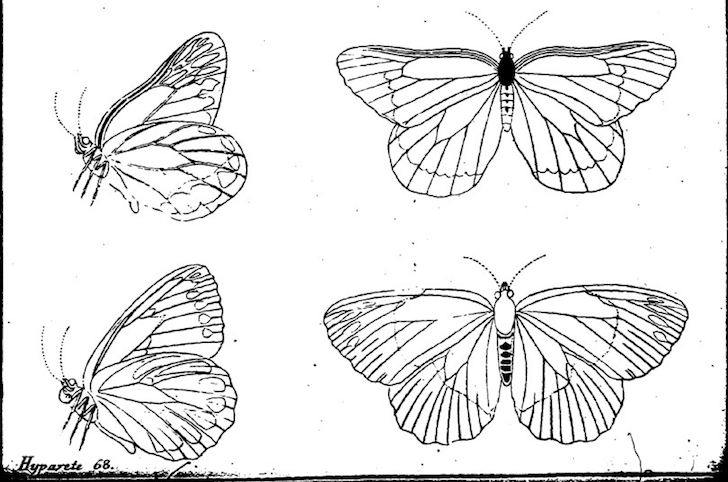 |
| Type illustration of Delias hyparete (Linnaeus, 1758) drawn by Carl Alexander Clerck (1759) in his book, Icones insectorum rariorum, Plate 38, Figure 2. Source: Bibliothèque nationale de France (Public Domain) |
However, in a subsequent review of the names of “Papilio” butterflies described by Linnaeus, the original holotype that was used to formally describe Delias hyparete in the Uppsala’s collection was not found[8]. Fortunately, the illustration of the type specimen can still be found in Clerck’s Icones insectorum rariorum, detailed on Plate 38, Figure 2, which Linnaeus referred to in another publication in 1764[24].
Delias hyparete metarete
Status: Holotype
Type Locality: Malaysia
Current depository: Natural History Museum, London
The type specimen for Delias hyparete metarete, the subspecies found in Singapore, is housed in the Natural History Museum with the catalogue number BMNH(E)149469.
[8.4] Scientific Classification
“It would be most interesting to attempt to trace in detail the phylogenetic history of the whole of this extensive genus” – Dixey (1894:301) remarking about the genus Delias.
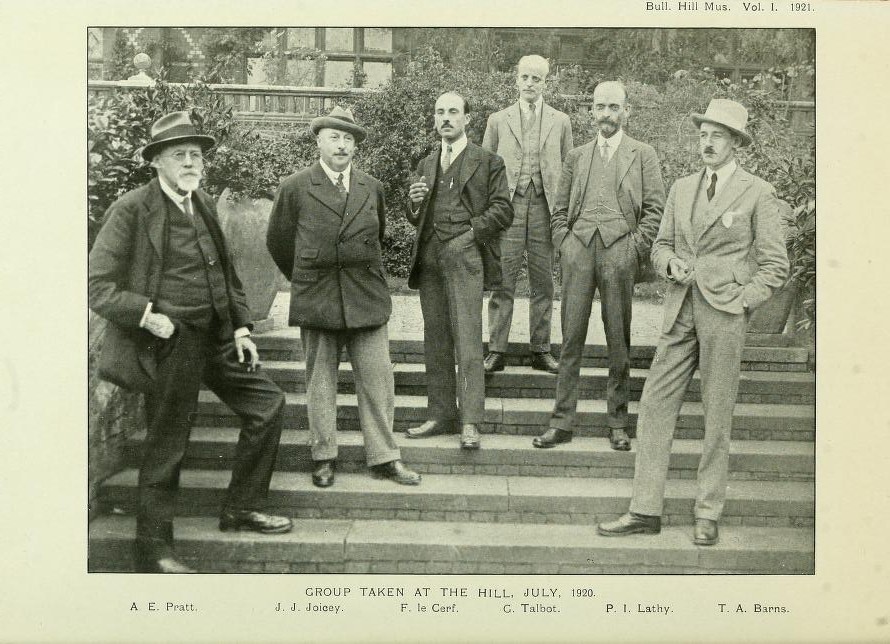 |
| George Talbot (third from right) and other entomologists at the Hill Museum in 1920. Source: Biodiversity Heritage Library (Public Domain) |
The first detailed taxonomic assessment of the genus, Delias, was originally done by George Talbot (1882-1952), an eminent English entomologist who specialised in butterflies, during the years (1928-1937) in his thorough monograph of the genus[12]. Basing his work on previous studies done by Wallace (1867), Dixey (1894) and others [7,14], he classified 153 species into 20 species-groups according to morphological differences in: (i) the form of the androconia, (ii) male genitalia structure, and (iii) wing patterns. It is interesting to note that the twenty species group as defined by Talbot were thought by him to be monophyletic in nature, although he cautioned that “still not satisfied as to the affinities and composition of the subgroups…” Under his classification, Delias hyparete was correspondingly placed within the hyparete-group.
[8.5] Phylogenetic Relations
Subsequent molecular and phylogenetic studies have supported the original classification of Delias hyparete within the hyparete-group. In particular, a study conducted by based on an analysis of 3 molecular markers (elongation factor-1 alpha (EF-1α), cytochrome oxidase subunits I (COI) and wingless) evaluated using maximum parsimony, and Bayesian inference with a combined dataset recovered fourteen distinct clades. In this study, the monophyly of the genus Delias is confirmed and analysis also supported the hyparete-group as a well-supported monophyletic group that had split from the other clades with a period of at least 15Ma[11]. From the calibrated tree, Delias hyparete's closest sister taxa is Delias mitisi whereby the two species split from a shared common ancestor in the late Pliocene period, approximately 3.60 – 2.58 million years ago.
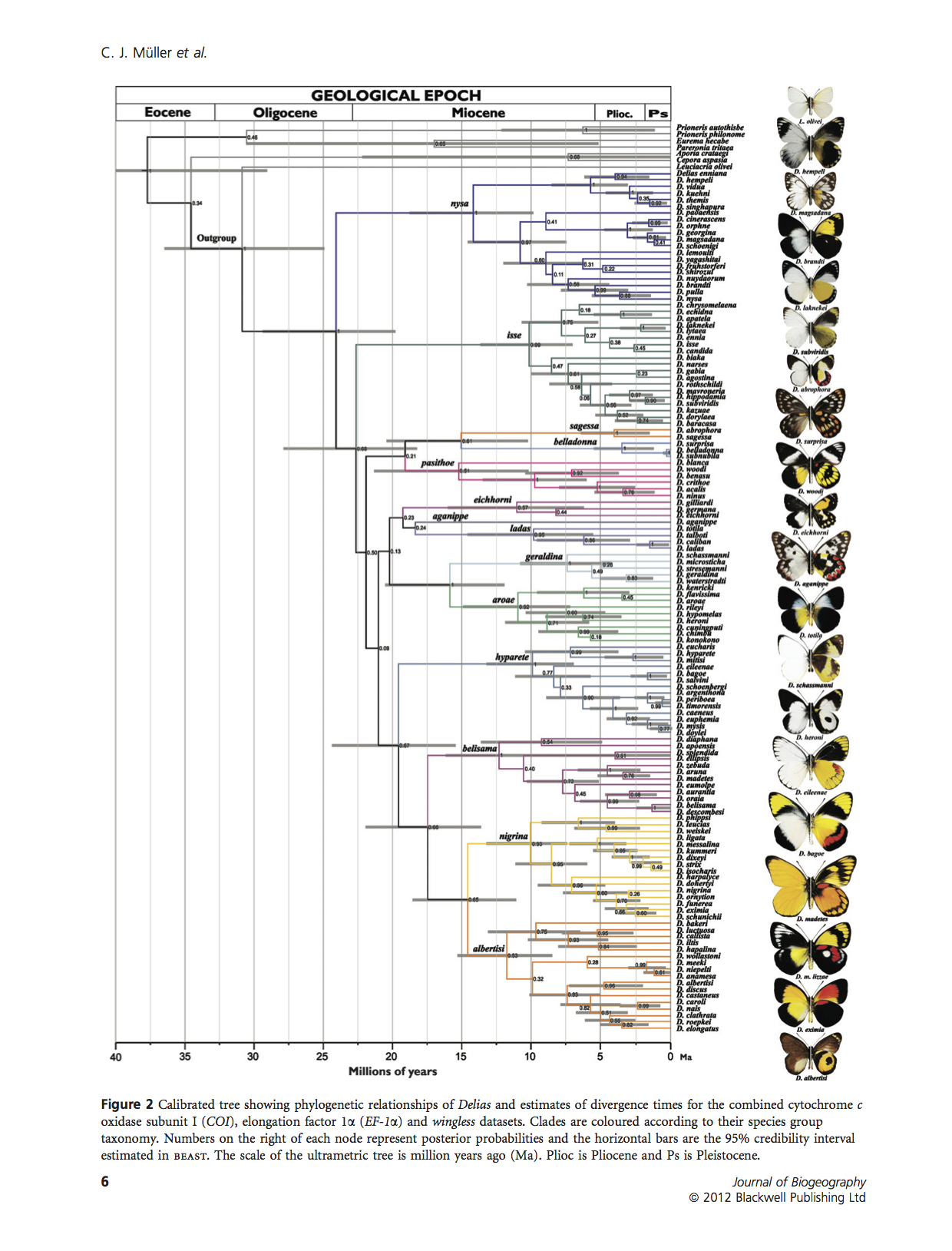 |
| Calibrated tree showing the phylogenetic relationships of Delias and the estimates of divergence times for the combined datasets of the three molecular markers. Clades are coloured according to their species group taxonomy. Horizontal bars are the 95% credibility interval estimated in BEAST.(Source: Muller, Matos-Maravi & Beheregaray, 2013) Direct permission not obtained but within the Limits of Fair Use |
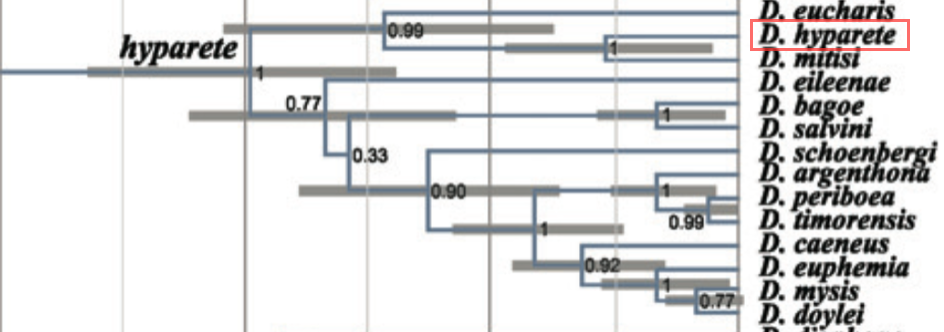 |
| Close-up of the hyparete-group as indicated in the calibrated tree. (Source: Muller, Matos-Maravi & Beheregaray, 2013) Direct permission not obtained but within the Limits of Fair Use |
[8.6] Historical Biogeography and Diversification
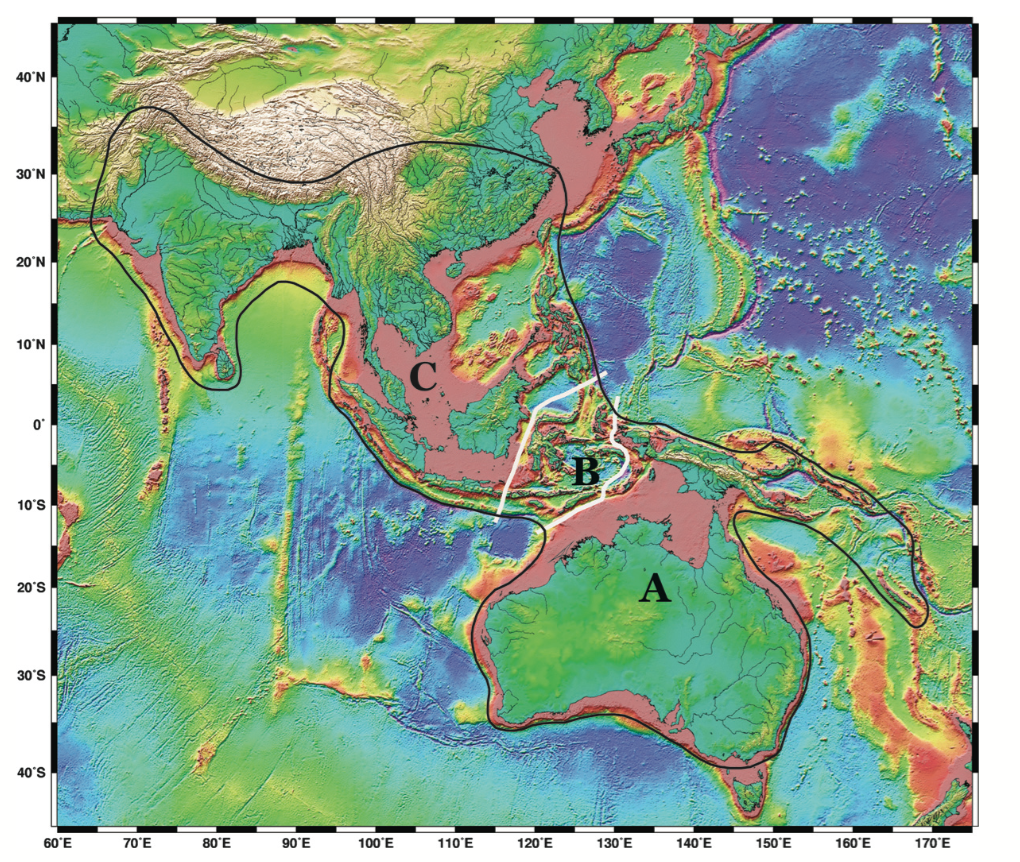 |
| Map of Indo-Australian region showing the geographical range of Delias (black border) and assigned biogeographical zones used in the dispersal-vicariance analysis: (A) Australian region, (B) Wallacea and (C) Southeast-Asia (Source: Muller, Matos-Maravi & Beheregaray, 2013) Direct permission not obtained but within the Limits of Fair Use |
In the same study, it was also suggested that most of the species-groups, including the hyparete-group originated in the early to mid Miocene (c. 24-15Ma). In the early days of the evolution of the genus, Delias was present as several clades in the Wallacea region and the analyses proposed that there were early dispersal events from Wallacea whereby the hyparete-group crossed over to Southeast-Asia during the late Miocene and Pliocene. Widespread clades such as the hyparete-group have also speciated largely on islands outside of the proposed Australian Plate origin for Delias [2,11].
[8.7] Synonyms
| Delias hyparete mindanaensis Mitis, 1893 |
|
||
| Delias hyparete palawanica Staudinger, 1889 |
|
||
| Delias hyparete peirene Fruhstorfer, 1908 |
|
||
| Pieris luzonensis Felder & Felder, 1862 |
Literature and References
[1]Braby, M. F. (2006). Evolution of larval food plant associations in Delias Hübner butterflies (Lepidoptera: Pieridae). Entomological Science, 9(4), 383-398. doi: 10.1111/j.1479-8298.2006.00185.x
[2]Braby, M. F., & Pierce, N. E. (2007). Systematics, biogeography and diversification of the Indo-Australian genus Delias Hübner (Lepidoptera: Pieridae): phylogenetic evidence supports an ‘out-of-Australia’ origin. Systematic Entomology, 32(1), 2-25. doi: 10.1111/j.1365-3113.2006.00349.x
[3]Butler, A. G. (1879). XXI. The Butterflies of Malacca*. Transactions of the Linnean Society of London. 2nd Series: Zoology, 1(8), 533-568. doi: 10.1111/j.1096-3642.1879.tb00493.x
[4]Corbet, A. S. (1949). The Linnaean Names of Indo-Australian Rhopalocera. Part 7. Summary of Determinations. Proceedings of the Royal Entomological Society of London. Series B, Taxonomy, 18(9-10), 191-200. doi: 10.1111/j.1365-3113.1949.tb01447.x
[5]Corbet, A. S., Pendlebury, H. M., Eliot, J. N., & D'Abrera, B. (1992). The Butterflies of the Malay Peninsula: Malayan Nature Society.
[6]Degeorges, F. A., & Pinratana, A. (1975). Butterflies in Thailand: Pieridae and Amathusiidae: Viratham Press.
[7]Dixey, F.A. (1894) On the phylogeny of the Pierinae, as illustrated by their wing-markings and geographical distribution. Trans- actions of the Entomological Society of London, 2, 249–334.
[8]Honey, M. R., & Scoble Fls, M. J. (2001). Linnaeus's butterflies (Lepidoptera: Papilionoidea and Hesperioidea). Zoological Journal of the Linnean Society, 132(3), 277-399. doi: http://dx.doi.org/10.1006/zjls.2001.0265
[9]Kirton, L. (2014). A Naturalist's Guide to the Butterflies of Peninsular Malaysia, Singapore and Thailand: John Beaufoy Publishing.
[10]Linnæus, C. (1758). Systema naturæ per regna tria naturæ, secundum classes, ordines, genera, species, cum characteribus, differentiis, synonymis, locis. Tomus I. Editio decima, reformata. - pp. [1-4], 1-824. Holmiæ. (Salvius).
[11]Müller, C. J., Matos-Maraví, P. F., & Beheregaray, L. B. (2013). Delving into Delias Hübner (Lepidoptera: Pieridae): fine-scale biogeography, phylogenetics and systematics of the world's largest butterfly genus. Journal of Biogeography, 40(5), 881-893. doi: 10.1111/jbi.12040
[12]Talbot, G. (1928). Monograph of the Pierine genus Delias.
[13]Tan, H., Khew, S. K., & Board, N. P. (2012). Caterpillars of Singapore's Butterflies: National Parks Board.
[14]Wallace, A.R. (1867) On the Pieridae of the Indian and Australian Regions. Transactions of the Entomological Society of London, 4, 301–415.
[15]Wee, Y. C. & A. Ng, (2008). Life history of the painted jezebel, Delias hyparete Linnaeus, 1758 (Order Lepidoptera). Nature in Singapore 1: 103-108.
[16]Yong, J. W., Wang, J., Khew, J. Y., Sheue, C., & Wong, W. (2014). A Guide to the Common Epiphytes and Mistletoes of Singapore
[17]Capinera, J. L. (2008). Encyclopedia of Entomology: Springer.
[18]Braby, M. F., Eastwood, R., & Murray, N. (2012). The subspecies concept in butterflies: has its application in taxonomy and conservation biology outlived its usefulness? Biological Journal of the Linnean Society, 106(4), 699-716. doi: 10.1111/j.1095-8312.2012.01909.x
[19]Mayr, E. (1942). Systematics and the Origin of Species, from the Viewpoint of a Zoologist: Harvard University Press.
[20]Butterflies of Singapore: Life History of Painted Jezebel by Horace Tan, 11 May 2013. URL:http://butterflycircle.blogspot.sg/2013/05/life-history-of-painted-jezebel.html (Accessed 5 November 2015)
[21]Kingsolver, J. G. (1985). Butterfly Thermoregulation: Organismic. Journal of Research on the Lepidoptera, 24(1), 1-20.
[22]Schmitz, H. (1994). Thermal characterization of butterfly wings—1. Absorption in relation to different color, surface structure and basking type. Journal of Thermal Biology, 19(6), 403-412. doi: http://dx.doi.org/10.1016/0306-4565(94)90039-6
[23]Hanebuth, T., Stattegger, K., & Grootes, P. M. (2000). Rapid flooding of the Sunda Shelf: a late-glacial sea-level record. Science, 288(5468), 1033-1035.
[24]Linnaeus C. (1764). Museum S:ae R:ae M:tis Ludovicae Ulricae Reginae. Holmiae
[25]ICZN. 1999. International code of zoological nomenclature. London: International Trust for Zoological Nomenclature.
